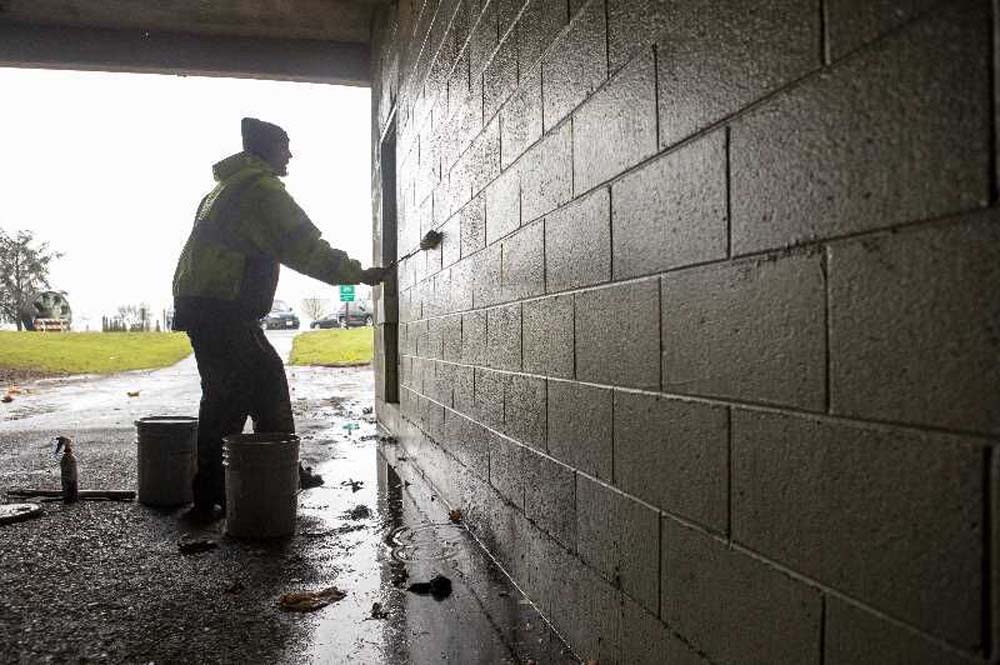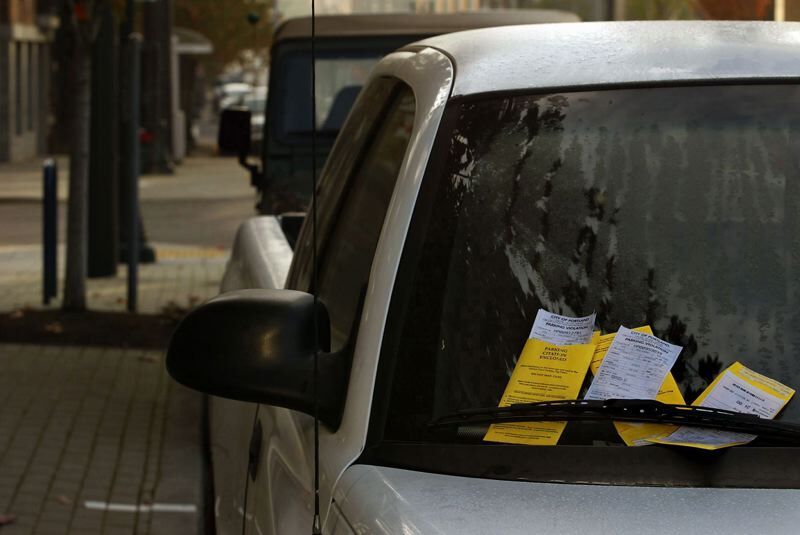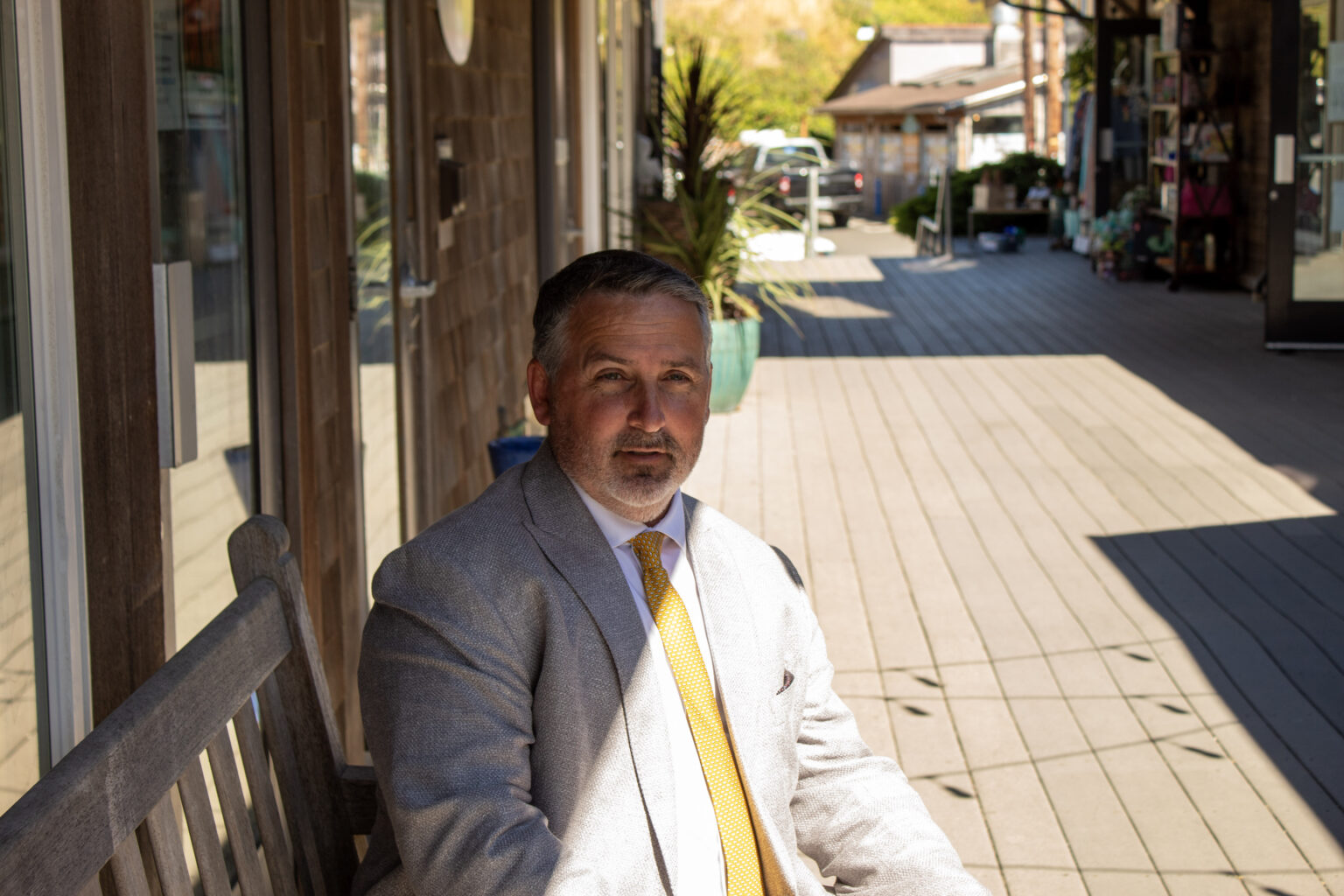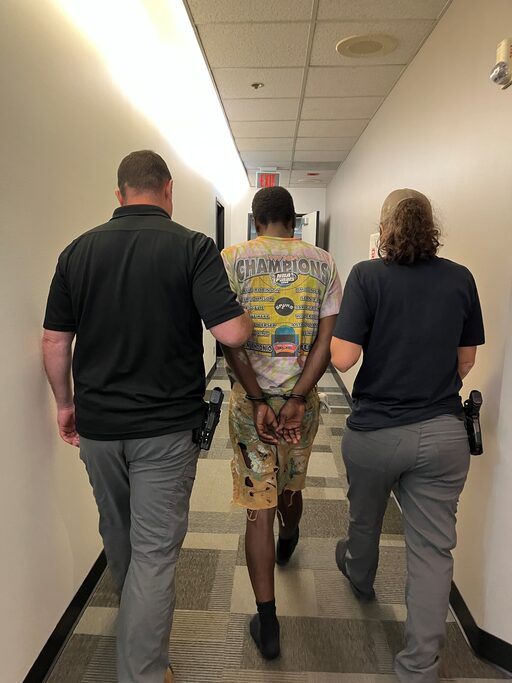Tag, you’re it: Scrubbing Portland’s graffiti
Published 12:00 am Wednesday, March 9, 2022

- Emory Loya, with Portland Graffiti Removal, painted over this tag in an I-5 underpass near the ODOT property at Jantzen Beach. He could not decipher it. When it rains it doesn't pour graffiti.
Jose Sandoval has worked for Portland Graffiti Removal for several weeks now.
Trending
Sandoval was out recently, painting the short underpass where Interstate 405 North exits to Northwest 14th Avenue and the Pearl District. With his bucket of “PBOT Gray” paint and a roller on a pole, he was hitting spots of Portland Bureau of Transportation property that were out of the rain.
Stopping to adjust his pole, Sandoval said he likes his job because, “It’s trying to fix the community.”
He painted this underpass gray on Friday Feb. 11, and by Monday, Feb. 14, it had been tagged. So, three days later he was doing it again. And he fully expects it to be tagged again soon.
Trending
He drives around using GPS, looking for graffiti on the I-405 that he can safely paint over. He parks in the shoulder and puts an orange flag behind the company truck. “You just drive and look around while you’re driving,” Sandoval said.
If the spot is too close to traffic and too dangerous, he must schedule a lane closure and come back another time.
Never-ending task
Sandoval came to Portland when he was 10 from California, where hard-to-read tags emerged in the 1980s, but that has been no help — he can’t read any of the elaborate handwriting he has to cover up.
“I think it’s gang related, some of it is,” he said pointing out some blue Sharpie work that said, “NORTHSIDE FAMILY 72 CRIP 72 DAEDAE.” Mostly it’s just short names in cryptic fonts.
Portland Graffiti Removal has a contract with the city of Portland to do this work. The company takes before-and-after photos every day and submits them to the city.
A “Sisyphean task” comes from Greek myth and is one that seems impossible to complete. Like painting over graffiti in Portland.
Asked if it ever ends, Sandoval said, “No. As soon (taggers) see new paint they go ‘Oh I could do something on this brand-new paint.'” He admits that some of it is “pretty creative” but adds “I’ve never been a fan of graffiti. But I feel like there’s better places to do it rather than around the whole city.”
He doesn’t listen to music on the job because it’s safer to stay alert for traffic.
The driving public seems supportive, he said, often honking or giving him a thumbs-up.
Other contractors
Vince West works at another cleaning service, Scorpion Surface. When asked if the graffiti problem is getting worse, West said yes, but not everywhere.
“It really depends on the neighborhood, but that’s correct for I-405, I-205 and I-84. A lot of our customers are on those streets and I’m out there every week, removing graffiti. The more often you remove it, it does seem to discourage it,” he said.
West said it’s hard to decode the writing, which comes in three categories. “One is territorial tagging; you see the same symbols and phrases. Some of it is political or because people are upset about racial or political events so they’re writing, ‘Trayvon Martin’ or something like that,” he said, referencing the 17-year-old African American from Miami Gardens, Florida, who was shot and killed in 2012.
“Some of them they’re artists, but unfortunately, they’re doing murals on private property,” West said. “Someone is obviously buying this paint, whether it’s tagging for territory, or like, ‘Hey, I made it that really cool whatever.'”
Scorpion works with private businesses and homeowners who have been tagged. He started out doing power washing and painting, but there were a lot of power washing companies. Then West and his partner had to pivot to graffiti removal when COVID-19 hit, because ethe economy slumped and graffiti went unchecked.
Are these rattle-can Rembrandts buying their own paint?
“I would imagine they are, but some of these removals… We did one the other day and it was probably 300 feet wide by 10 or 12 feet high, and it was 16 colors,” West said. “I can’t imagine how much spray paint that was. But then I don’t know where you’re stealing it from, because every store I go into, the spray paint is locked up. Maybe they’re using professional paint sprayers?”
Other options
Emory Loya has been with his stepfather’s company, Portland Graffiti Removal, for two-and-a-half years. He says he is treated a lot better than at his previous Subway job. A typical day is meeting the four other guys at the office at 6 a.m., eating breakfast, loading the branded minivan, then cruising the freeways looking for graffiti to paint over or wash off.
Loya does jobs on ODOT property and on private property. Businesses can phone in and pay for Portland Graffiti Removal to clean off their graffiti.
According to the city of Portland’s Office of Community & Civic Life, businesses with 10 employees or more and residences with 10 or more units must arrange their own graffiti removal clean-up.
Civic Life’s program deploys contractors to resolve graffiti tags for the following types of organization at no or low cost, including:
n Businesses with one to 10 employees
n Non-profit organizations
n Private residences (one to 10 units)
n All hate speech and gang graffiti
Many cities including Seattle and San Francisco do not provide free or low-cost contractor clean-up services for businesses or non-profits.
Metro Paint and Civic Life’s Graffiti Program collaborated to create Clean It Out and Paint It Out kits. These free kits — paint, pans and rollers — are available for neighborhood groups and individuals to paint over graffiti themselves.
On a recent, wet Monday, Loya and his partner, Tyshun Gant, had been driving around for hours looking for a dry place to paint. With high winds and heavy rain, it seemed every wall was wet from Vancouver to Salem. Eventually they settled on the pedestrian tunnel under I-5 at Jantzen Beach, next to the ODOT testing center. Gant covered up a small tag on a beam high up, which Loya said the tagger had climbed up some metal gates to reach. They were going to clean small Sharpie words on a reflective metal sign. And then Loya painted over another tag on the entrance to the subway.
“That’s a given with this business, as soon as that gets cleaned up, the artist thinks of it as a new canvas. So once it’s cleaned, it gets re-tagged and we just come back and repeat the process. And it’s just never ending,” he said with a chuckle.
Loya names a few names he sees a lot: “This guy Delay, he’s pretty talented, I must say. That’s the only guy that’s piqued my interest to look at his stuff more. There’s Parley, another is Grito…I think they’re just doing it because they want to get recognition. People could drive by and see they have talent or not. It’s mainly about trying to get as many people as possible to see it,” Loya said.
“As soon as I paint it, I give at least one night, and two days and it’s already covered,” Loya said.
Asked about people tagging the concrete medians on I-84, with cars going a few feet from their head at 80 miles per hour, he added, “They’re really well aware of what they’re doing and what risk they’re taking.”
Both Loya and Sandoval seem mellow, resigned to their endless task. But that’s not to say they like Portland’s current distressed 1980s look.
Loya theorizes that painting over fresh graffiti probably frustrates the taggers and pushes them to other areas but doesn’t think they worry about the difference between private and publicly owned walls. “I’m sure they do (know the difference) but I just don’t think they really care, as long as they’re still being able to do their hobby or whatnot.”
Two coats in summer
The two methods are painting over tags in ODOT gray, and applying a solvent called Sensitive Surface and blasting it off with pressurized hot water.
Loya think the taggers pay for their paints, since they are hard to steal now. “I guess they have money to spend. I’m sure every one of them has jobs. I’m sure they see me putting up paint and are honking at me and flipping me off and whatnot.”
Summer is peak graffiti season, when Loya gets five to 20 jobs per day. “The goal is to make it look as clean as possible, to square off the edges. We to try to block everything out and make every line straight.”
Loya said he’s some taggers.
“I’ve had a few talk to me, and some of them have been really cool about it. I explained my views on their art and they’re usually understanding about it. I tell them, I enjoy seeing graffiti once in a while, if it’s really good graffiti. But if I show an example of it being really terrible, they’re like, ‘Yeah, cover that up.'”
Loya said the demographic of the people he sees spray painting is “12-year-olds to, like, 26. I was driving one time and I saw a little kid start writing on a little (electrical) box. I honked my horn. He looked around and just kept doing it.”
Loya was raised at 62nd and Foster and now lives near Gresham. He loves Portland, he said. “Regardless, the good and the bad, it’s home. I will probably be here for the rest of my life. But it’s just going through a phase at the moment. Within the next five to 10 years, it will get back to where it was. It’s beautiful. This isn’t what it is.”







